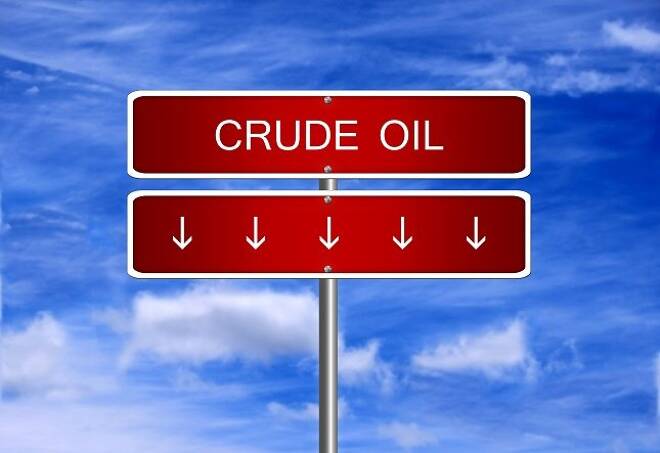Advertisement
Advertisement
Crude Oil Price Analysis for April 28, 2017
By:
Oil prices traded under pressure on Thursday despite Wednesday’s surprise draw reported by the Energy Information Administration. Libya’s production is
Oil prices traded under pressure on Thursday despite Wednesday’s surprise draw reported by the Energy Information Administration. Libya’s production is coming back on line which weighed on prices, as the bullish case for oil continues to ease. OPEC is likely to begin to jawbone if prices fall below the $48 handle.
Technicals
Prices whipsawed sharply declining but holding support near an upward sloping trend line that comes in near 48.20. Prices rebounded late in the session to close down nearly 1%, at 49.14. This trend line is the neck line of a fully formed head and shoulder pattern. For this to continue to play out, prices would need to close through the neckline on surging volume. The next level of target resistance would be the November lows at 46. The head and shoulder pattern is a reversal pattern, and the way the target support is calculated is taking the difference between the head and the neckline and adding that to the breakdown level. So, 48-10 would target the 38 level.
Momentum remains negative as the MACD (moving average convergence divergence) index prints in the red with a downward sloping trajectory which points to lower prices for crude oil. The RSI (relative strength index) is printing a reading of 35, which is on the lower end of the neutral range.
The World Bank Confirms its Oil Forecast
The World Bank kept its oil forecast unchanged and is overall optimistic for oil, expecting supply to tighten in the current quarter as OPEC and non-OPEC production cuts start to affect global supply. In that, the institution differs from some energy analysts who are markedly bearish on oil prices.
U.S. Durable Goods Rose More than Expected
U.S. durable goods orders rose 0.7% in March after a 2.3% increase in February which was revised from 1.8% and a 2.4% January surge. Transportation orders climbed 2.4% versus February’s 5.5% jump which was revised from 4.4%. But excluding transportation, orders dipped 0.2% after edging up 0.7% previously which was revised from 0.5%. Nondefense capital goods orders excluding aircraft rose 0.2% from 0.1% in February which was revised from -0.1% and 0.2% in January which was revised from 0.1%. Shipments edged up 0.2% in March after a 0.2% February increase which was revised from 0.3%. Nondefense capital goods shipments excluding aircraft were up 0.4% from 1.1% which was revised from 1.0%. Inventories increased 0.1% from 0.2%. The inventory-shipment ratio was flat at 1.61 for a fourth month.
Jobless Claims Rose More than Forecast
U.S. initial jobless claims rose 14k to 257k in the week ended April 22, from 243k last week which was revised from 244k. That brought the 4-week moving average to 242.25k from 242.75k which was revised from 243k. Continuing claims rose 10k to 1,988k in the April 15 week versus 1,978k previously which was revised from 1,979k. This week’s figures were likely impacted somewhat by the Easter holiday.
The U.S. Trade Deficit Widened
U.S. Advance trade deficit in goods widened slightly to -$64.8 billion from a revised -$63.9 billion which was -$64.8 billion. Exports dipped 0.5% to $119.0 billion amid a 5.1% drop in automotive exports and a 1.7% decline in capital goods. Imports rose 1.4% and a 5.3% surge in industrial supplies and an 8.8% jump in other goods. Also, advance wholesale inventories fell 0.1% in March from a revised 0.2% gain which was 0.4%, and advance retail inventories increased 0.4% after a 0.4% February gain.
A strong Dollar is Bearish for Crude
The dollar also benefited on Thursday which was partially a function of Draghi’s mixed message. It appears that the ECB feels that the balance of risk to growth outlook was subject to discussion. Draghi seemed to ignore that the second round of the French presidential election would have an impact on the central bank’s assessment and the risks it implies. However, in the end it seems the hawks gave in and supported the official statement, maybe also because as we suspect the doves hinted that the forward guidance will be finally be tweaked in June.
ECB hasn’t discussed exit steps so far and the central bank president also brushed off questions on the possibility of a situation where rates could be hiked even as QE is still ongoing, but being scaled back. At the moment, the statement still reads that rates will remain at present or lower levels well beyond the period of asset purchases, which if tapering starts early next year, would rule out a rate hike before QE is fully phased out.
About the Author
David Beckerauthor
David Becker focuses his attention on various consulting and portfolio management activities at Fortuity LLC, where he currently provides oversight for a multimillion-dollar portfolio consisting of commodities, debt, equities, real estate, and more.
Did you find this article useful?
Latest news and analysis
Advertisement
